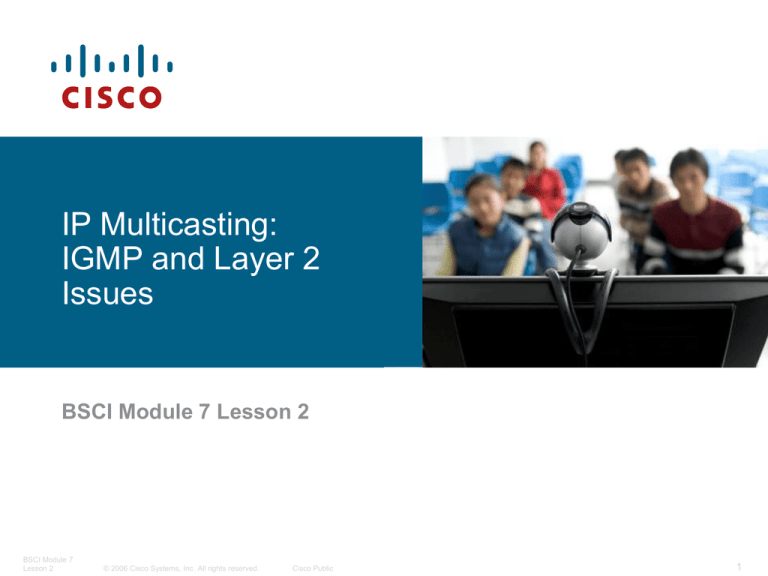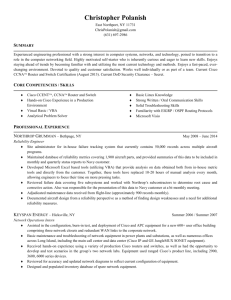
IP Multicasting:
IGMP and Layer 2
Issues
BSCI Module 7 Lesson 2
BSCI Module 7
Lesson 2
© 2006 Cisco Systems, Inc. All rights reserved.
Cisco Public
1
Objectives
Explain the operations of IGMPv2 and how IGMPv2
utilizes Join Group and Leave Group messages.
Explain the operations of IGMPv3 and how IGMPv2
and IGMPv3 interoperate.
Describe the methods used to deal with multicast in a
Layer 2 switching environment.
BSCI Module 7
Lesson 2
© 2006 Cisco Systems, Inc. All rights reserved.
Cisco Public
2
IGMP Overview
BSCI Module 7
Lesson 2
© 2006 Cisco Systems, Inc. All rights reserved.
Cisco Public
3
Internet Group Management Protocol
(IGMP)
How hosts tell routers about group membership
Routers solicit group membership from directly
connected hosts
RFC 1112 specifies IGMPv1
Supported on Windows 95
RFC 2236 specifies IGMPv2
Supported on latest service pack for Windows and most
UNIX systems
RFC 3376 specifies IGMPv3
Supported in Window XP and various UNIX systems
BSCI Module 7
Lesson 2
© 2006 Cisco Systems, Inc. All rights reserved.
Cisco Public
4
IGMPv2
RFC 2236
Group-specific query
Router sends query membership message to a single group
rather than all hosts (reduces traffic).
Leave group message
Host sends leave message if it leaves the group and is the last
member (reduces leave latency in comparison to v1).
Query-interval response time
The Query router sets the maximum Query-Response time
(controls burstiness and fine-tunes leave latencies).
Querier election process
IGMPv2 routers can elect the Query Router without relying on
the multicast routing protocol.
BSCI Module 7
Lesson 2
© 2006 Cisco Systems, Inc. All rights reserved.
Cisco Public
5
IGMPv2—Joining a Group
224.1.1.1
Join Group
BSCI Module 7
Lesson 2
© 2006 Cisco Systems, Inc. All rights reserved.
Cisco Public
6
IGMPv2—Leaving a Group
IGMPv2 has explicit Leave Group messages, which
reduces overall leave latency.
BSCI Module 7
Lesson 2
© 2006 Cisco Systems, Inc. All rights reserved.
Cisco Public
7
IGMPv2—Leaving a Group (Cont.)
Hosts H2 and H3 are members of group 224.1.1.1.
1. H2 sends a leave message.
BSCI Module 7
Lesson 2
© 2006 Cisco Systems, Inc. All rights reserved.
Cisco Public
8
IGMPv2—Leaving a Group (Cont.)
2. Router sends group-specific query.
BSCI Module 7
Lesson 2
© 2006 Cisco Systems, Inc. All rights reserved.
Cisco Public
9
IGMPv2—Leaving a Group (Cont.)
3. A remaining member host sends report, so group
remains active.
BSCI Module 7
Lesson 2
© 2006 Cisco Systems, Inc. All rights reserved.
Cisco Public
10
IGMPv2—Leaving a Group (Cont.)
BSCI Module 7
Lesson 2
© 2006 Cisco Systems, Inc. All rights reserved.
Cisco Public
11
IGMPv2—Leaving a Group (Cont.)
BSCI Module 7
Lesson 2
© 2006 Cisco Systems, Inc. All rights reserved.
Cisco Public
12
IGMPv3—Joining a Group
Joining member sends IGMPv3 report to 224.0.0.22
immediately upon joining.
BSCI Module 7
Lesson 2
© 2006 Cisco Systems, Inc. All rights reserved.
Cisco Public
13
IGMPv3—Joining Specific Source(s)
IGMPv3 Report contains desired sources in the
Include list. Only “Included” sources are joined.
BSCI Module 7
Lesson 2
© 2006 Cisco Systems, Inc. All rights reserved.
Cisco Public
14
IGMPv3—Maintaining State
Router sends periodic queries:
All IGMPv3 members respond.
Reports contain multiple group state records.
BSCI Module 7
Lesson 2
© 2006 Cisco Systems, Inc. All rights reserved.
Cisco Public
15
Self Check
1. What is the primary purpose of IGMP?
2. When 2 IGMP routers are located on the same
Ethernet segment, which router will be the designated
querier?
3. What does the ICMPv2 Query router doe when it
receives a Leave Message?
BSCI Module 7
Lesson 2
© 2006 Cisco Systems, Inc. All rights reserved.
Cisco Public
16
IGMP Layer 2
Issues
BSCI Module 7
Lesson 2
© 2006 Cisco Systems, Inc. All rights reserved.
Cisco Public
17
Determining IGMP Version Running
Determining which IGMP version is running on an
interface.
rtr-a>show ip igmp interface e0
Ethernet0 is up, line protocol is up
Internet address is 1.1.1.1, subnet mask is 255.255.255.0
IGMP is enabled on interface
Current IGMP version is 2
CGMP is disabled on interface
IGMP query interval is 60 seconds
IGMP querier timeout is 120 seconds
IGMP max query response time is 10 seconds
Inbound IGMP access group is not set
Multicast routing is enabled on interface
Multicast TTL threshold is 0
Multicast designated router (DR) is 1.1.1.1 (this system)
IGMP querying router is 1.1.1.1 (this system)
Multicast groups joined: 224.0.1.40 224.2.127.254
BSCI Module 7
Lesson 2
© 2006 Cisco Systems, Inc. All rights reserved.
Cisco Public
18
Layer 2 Multicast Frame Switching
Problem: Layer 2 flooding of multicast
frames
Typical Layer 2 switches treat
multicast traffic as unknown or
broadcast and must flood the frame
to every port (in VLAN).
Static entries may sometimes be set
to specify which ports receive which
groups of multicast traffic.
Dynamic configuration of these
entries may reduce administration.
BSCI Module 7
Lesson 2
© 2006 Cisco Systems, Inc. All rights reserved.
Cisco Public
19
Layer 2 Multicast Switching Solutions
Cisco Group Management Protocol (CGMP): Simple,
proprietary; routers and switches
IGMP snooping: Complex, standardized, proprietary
implementations; switches only
BSCI Module 7
Lesson 2
© 2006 Cisco Systems, Inc. All rights reserved.
Cisco Public
20
Layer 2 Multicast Frame Switching
CGMP
Solution 1: CGMP
Runs on switches and routers.
CGMP packets sent by routers to
switches at the CGMP multicast MAC
address of 0100.0cdd.dddd.
CGMP packet contains:
Type field: join or leave
MAC address of the IGMP client
Multicast MAC address of the group
Switch uses CGMP packet information to
add or remove an entry for a particular
multicast MAC address.
BSCI Module 7
Lesson 2
© 2006 Cisco Systems, Inc. All rights reserved.
Cisco Public
21
IGMP Snooping
Solution 2: IGMP snooping
Switches become IGMP-aware.
IGMP packets are intercepted by the CPU or by
special hardware ASICs.
Switch examines contents of IGMP messages to learn
which ports want what traffic.
Effect on switch without Layer 3-aware
Hardware/ASICs
Must process all Layer 2 multicast packets
Administration load increased with multicast traffic
load
Effect on switch with Layer 3-aware Hardware/ASICs
Maintain high-throughput performance but cost of
switch increases
BSCI Module 7
Lesson 2
© 2006 Cisco Systems, Inc. All rights reserved.
Cisco Public
22
IGMPv3 and IGMP Snooping
Impact of IGMPv3 on IGMP Snooping
IGMPv3 Reports are sent to a separate group (224.0.0.22)
reduces load on switch CPU
No Report Suppression in IGMPv3
IGMP Snooping should not cause a serious
performance problem once IGMPv3 is implemented.
BSCI Module 7
Lesson 2
© 2006 Cisco Systems, Inc. All rights reserved.
Cisco Public
23
Self Check
1. What command is used to determine the version of
IGMP active on an interface?
2. How does a typical layer 2 switch treat multicast
traffic?
3. What is CGMP?
4. What type of switch is recommending for use with
IGMP snooping?
BSCI Module 7
Lesson 2
© 2006 Cisco Systems, Inc. All rights reserved.
Cisco Public
24
Summary
IGMPv2 is a protocol used by multicast clients to join a
multicast group.
IGMPv3 allows a receiver to specify a source.
If controls such as CGMP and IGMP snooping are not
added at the Ethernet switching level, all multicast
frames are flooded.
CGMP is a Cisco proprietary protocol used to
implement multicast efficiently.
IGMP snooping is a standard protocol that has a
function similar to CGMP.
BSCI Module 7
Lesson 2
© 2006 Cisco Systems, Inc. All rights reserved.
Cisco Public
25
Q and A
BSCI Module 7
Lesson 2
© 2006 Cisco Systems, Inc. All rights reserved.
Cisco Public
26
Resources
Wikipedia IGMP article
http://en.wikipedia.org/wiki/IGMP
Multicast in a Campus Network: CGMP and IGMP
Snooping
http://www.cisco.com/warp/public/473/22.html
IP Multicast Glossary of Terms
http://www.cisco.com/en/US/tech/tk828/tech_brief0900aecd801
bca26.html
BSCI Module 7
Lesson 2
© 2006 Cisco Systems, Inc. All rights reserved.
Cisco Public
27
BSCI Module 7
Lesson 2
© 2006 Cisco Systems, Inc. All rights reserved.
Cisco Public
28



